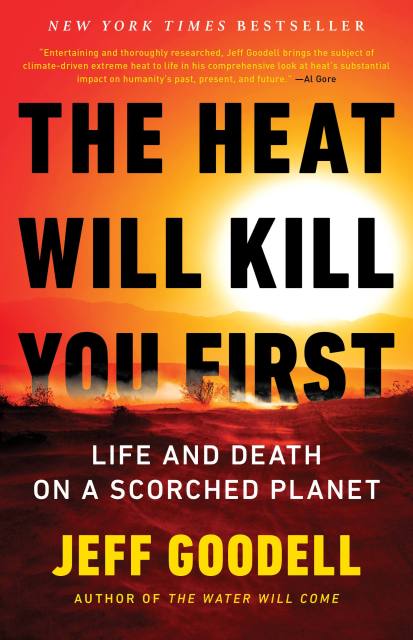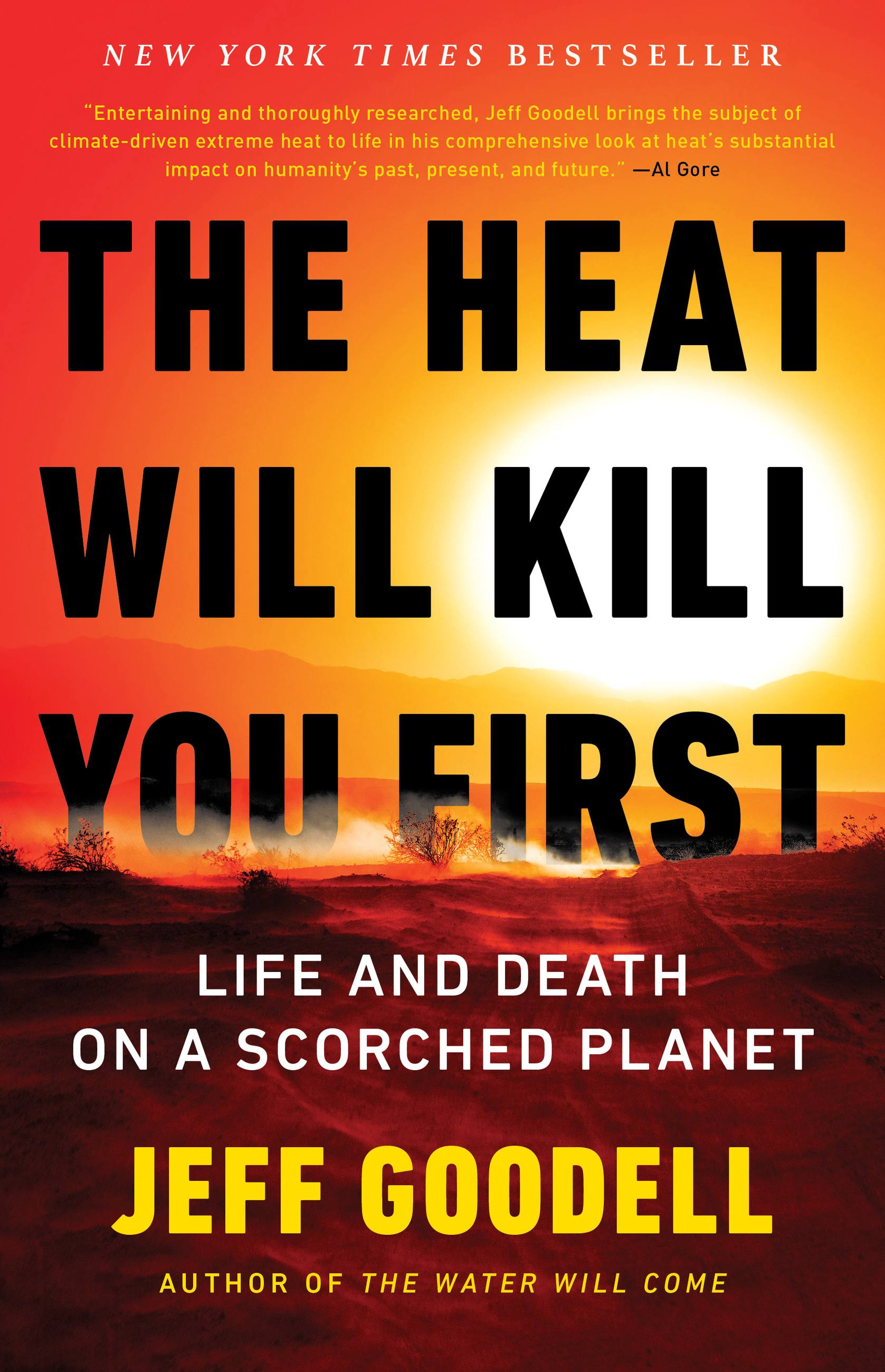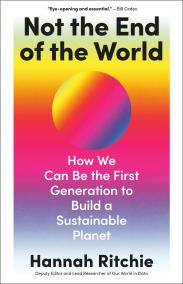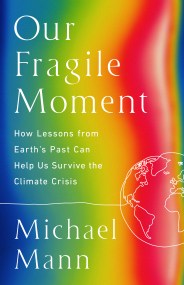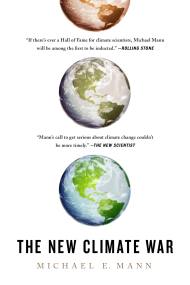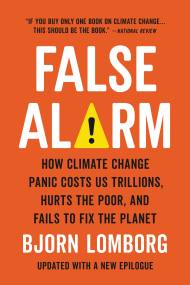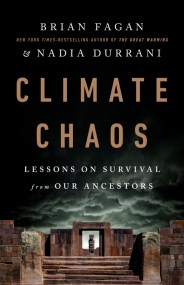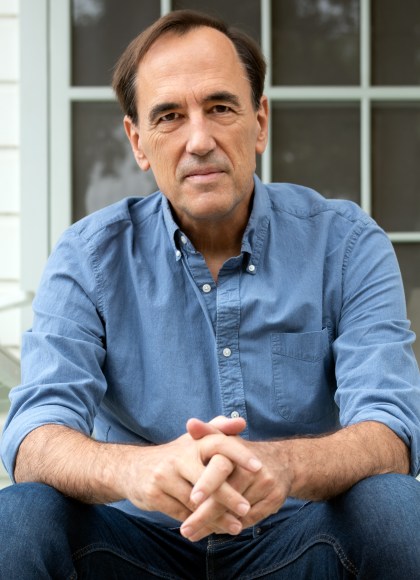Promotion
Use code MOM24 for 20% off site wide + free shipping over $45
The Heat Will Kill You First
Life and Death on a Scorched Planet
Contributors
By Jeff Goodell
Formats and Prices
Price
$29.00Price
$37.00 CADFormat
Format:
- Hardcover $29.00 $37.00 CAD
- ebook $14.99 $19.99 CAD
- Audiobook Download (Unabridged) $27.99
- Trade Paperback $23.99 $30.99 CAD
This item is a preorder. Your payment method will be charged immediately, and the product is expected to ship on or around July 11, 2023. This date is subject to change due to shipping delays beyond our control.
Also available from:
New York Times best-selling journalist Jeff Goodell presents a "masterful, bracing" (David Wallace-Wells) examination of the impact that temperature rise will have on our lives and on our planet, offering a vital new perspective on where we are headed, how we can prepare, and what is at stake if we fail to act.
“When heat comes, it’s invisible. It doesn’t bend tree branches or blow hair across your face to let you know it’s arrived…. The sun feels like the barrel of a gun pointed at you.”
The world is waking up to a new reality: wildfires are now seasonal in California, the Northeast is getting less and less snow each winter, and the ice sheets in the Arctic and Antarctica are melting fast. Heat is the first order threat that drives all other impacts of the climate crisis. And as the temperature rises, it is revealing fault lines in our governments, our politics, our economy, and our values. The basic science is not complicated: Stop burning fossil fuels tomorrow, and the global temperature will stop rising tomorrow. Stop burning fossil fuels in 50 years, and the temperature will keep rising for 50 years, making parts of our planet virtually uninhabitable. It’s up to us. The hotter it gets, the deeper and wider our fault lines will open.
The Heat Will Kill You First is about the extreme ways in which our planet is already changing. It is about why spring is coming a few weeks earlier and fall is coming a few weeks later and the impact that will have on everything from our food supply to disease outbreaks. It is about what will happen to our lives and our communities when typical summer days in Chicago or Boston go from 90° F to 110°F. A heatwave, Goodell explains, is a predatory event— one that culls out the most vulnerable people. But that is changing. As heatwaves become more intense and more common, they will become more democratic.
As an award-winning journalist who has been at the forefront of environmental journalism for decades, Goodell’s new book may be his most provocative yet, explaining how extreme heat will dramatically change the world as we know it. Masterfully reported, mixing the latest scientific insight with on-the-ground storytelling, Jeff Goodell tackles the big questions and uncovers how extreme heat is a force beyond anything we have reckoned with before.
Genre:
-
“Entertaining and thoroughly researched, Jeff Goodell brings the subject of climate-driven extreme heat to life in his comprehensive look at heat’s substantial impact on humanity’s past, present, and future.”Former Vice President Al Gore
-
“Through stellar reporting, artful storytelling and fascinating scientific explanations, Goodell brings to life heat as a world re-making force. In his skillful hands, the climbing temperature is revealed as an invisible, planetary animator that is already pushing landscapes, bodies, and social systems to their limits – and, unless we change course, it will take humanity to an oven-like climate that will feel more like a war than a home. This searing plea for a better, fairer and cooler future should be read by anyone with skin in the game – which is every single one of us.”Naomi Klein, author of the New York Times bestselling This Changes Everything
-
"In his fast-paced new book about climate change. . .Goodell denounces the term 'global warming' for sounding 'gentle and soothing.' As this terrifying book makes exceptionally clear, thinking we can just crank up the A.C. is a dangerous way to live. This is a propulsive book, one to be raced through; the planet is burning, and we are running out of time."Jennifer Szalai, The New York Times
-
"The climate crisis brings no greater threat than the prospect of deadly extreme heat. In The Heat Will Kill You First, Jeff Goodell brings a mix of fantastic storytelling, lucid science communication, and eternal optimism in detailing the profound threat we face with the climate crisis and what we can still do about it.”Michael Mann, Presidential Distinguished Professor, University of Pennsylvania and author of The New Climate War
-
“It is already a new world, hotter than ever before in human history and getting rapidly hotter still. The Heat Will Kill You First is a masterful, bracing, vivid portrait of the future we now know will be shaped, like clay, by that heat—a godlike force, as Goodell writes, governing all life conducted under its profound and brutal reign.”David Wallace-Wells, author of The New York Times bestselling The Uninhabitable Earth
-
“This is a scary book. It humanizes global warming by telling amazing stories of individuals already affected by it, making very clear the danger we are putting ourselves in. We all have a cognitive map in our head that includes a near future, which is sketchier than our map of the present, being made of our hopes and fears. This book will sharpen that sketch in electrifying ways. You won’t see the world the same way after reading it.”Kim Stanley Robinson, New York Times bestselling author of The High Sierra and The Ministry for the Future
-
"If you have ever sweated through a heatwave and wondered how much worse things are going to get as temperatures continue to rise around the planet, then Jeff Goodell's The Heat Will Kill You First is just the book for you. Meticulously researched yet thoroughly readable, this is at once a portrait of a heat-disrupted world and a primer for how to prepare for it."Amitav Ghosh, bestselling author of The Nutmeg’s Curse and The Great Derangement
-
“As the planet warms, all our assumptions are going to be upended. Jeff Goodell asks us to imagine the impact on our minds and bodies, our communities and economies. The Heat Will Kill You First is essential reading for anyone who cares about the future.”Elizabeth Kolbert, Pulitzer Prize winning author of The Sixth Extinction
-
"[Goodell] provides an intimate look at the effects of our planet's warming on individual lives...another stark, crucial reminder that we are running out of time to save humankind."Kirkus Reviews (Starred Review)
-
"Once you read this book, you may never see a hot summer day the same way again. Jeff Goodell gives heat names, faces, stories, and emotions that you will find hard to forget."Andrea Dutton, MacArthur Fellow and Professor of Geology, University of Wisconsin–Madison
-
“With his trademark blend of meticulous research, vivid storytelling, and unflinching honesty, Goodell exposes the devastating toll that extreme heat is already taking on communities around the world, and the inspiring efforts of scientists, activists, and everyday people who are working tirelessly to find solutions. Urgent, compelling, and deeply informative, The Heat Will Kill You First is a must-read for anyone who cares about the future of our planet…I couldn’t put it down.”Eleni Myrivili, Global Chief Heat Officer, UN-Habitat
-
"In 14 whirlwind chapters, Goodell, a longtime climate journalist and contributing editor for Rolling Stone, earns his book’s grim title. The chapters travel from the Arctic Circle to the tropics and back again, tracing the effects of heat on melting ice andsuffering corals, but also on enthused mosquitoes, whose ranges are stretching wider as temperatures warm....The scariest thing about the heat-infused future, Goodell notes, is that we don’t treat it with the respect and concern that it deserves."The Washington Post
-
"Astonishing"Time, Health Matters
-
"An urgent warning."PBS NewsHour
-
"A remarkable exploration of the deadly consequences of rising temperatures...The book’s biggest takeaway is that the harm from heat falls unfairly on those least able to protect themselves....Unlike some climate-science writers who drown readers in data and seem to write only for other activists, Mr Goodell tells his story colourfully. Readers meet people working to raise awareness of climate change by figuring out which extreme weather events can be attributed to it, and helping its victims by leaving water for migrants crossing the Arizona desert or campaigning for safer conditions for farmworkers….The Heat Will Kill You First could not be more timely.”The Economist
-
"Heat has a public relations problem, argues journalist Jeff Goodell in his latest book, The Heat Will Kill You First: Life and Death on a Scorched Planet. Most of us are familiar with the temperature readings we see on the nightly news, usually the temperature of the air around us or the heat index—a gauge of air temperature and humidity. But during the latest U.S. heat wave, some areas reported what’s known as wet bulb temperatures—a measurement of the lowest temperature that the evaporation of water can cool air—of 94 degrees. This measurement in ambient air temperature may not seem like a big deal to many people. But it’s a dangerous measurement in wet bulb temperatures, Goodell explains in his book. The higher the wet bulb temperature, the less effective evaporation is, and the harder it is for our sweat to cool us down."New Republic
-
"Read this book and then look at the temperatures in the northern hemisphere. That's the Anthropocene: so hot, it's chilling."Jeff Sparrow, The Saturday Paper
-
“They’re no disputing that Goodell is an engaging writer at the top of his game. He's like the love child of Ed Yong and James Patterson, with a little bit of Rachel Carson thrown in, which is to say he writes science-based dystopian thrillers."Jennifer Graham, The Hippo
-
"As The Heat Will Kill You First makes clear, the time to mitigate the sources and effects of rising temperatures is now."Inside Higher Ed
-
“Goodell’s brilliant and sobering book can help inspire a critical mass of people to “reimagine everything” and join the fight to create a habitable future.”Sierra Magazine
-
“'Prescient' and 'gripping' are two words that come to mind when describing Goodell’s latest book. Goodell guides us clearly with clear science and great storytelling.”The Los Angeles Times
-
"The Heat Will Kill You First is arguably also one of the most eloquent books — and one of the most terrifying — to hit the global bookshelf. Because Heat brings home the perilous urgency of the current moment like no other."Bron Sibree, Sunday Times
"the extraordinary power of Goodell’s narrative is the way he renders cutting-edge science understandable, adroitly interweaving scientific detail, relevant statistics and conversations with scientists with the stories of ordinary individuals to drive home the invisible power of “this form of heat that has been unleashed upon us through the burning of fossil fuels”. -
“The Heat Will Kill You First spans the globe, with Goodell constantly on assignment, jumping from melting icebergs in Antarctica to the scalding streets of Chennai. His stories make heat, and the dangers it incites, visible in new ways.”John Washington, New York Review of Books
- On Sale
- Jul 11, 2023
- Page Count
- 400 pages
- Publisher
- Little, Brown and Company
- ISBN-13
- 9780316497572
Newsletter Signup
By clicking ‘Sign Up,’ I acknowledge that I have read and agree to Hachette Book Group’s Privacy Policy and Terms of Use
